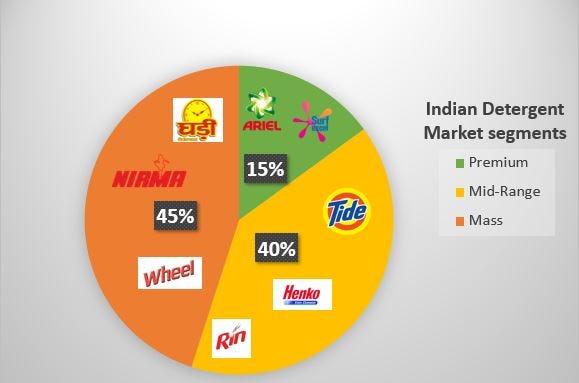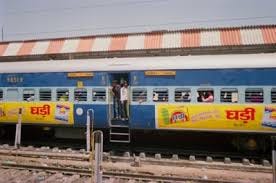SNAP #8: How did Ghari become the No.1 detergent brand in India?
Read Time: 4 minutes
7,000+ curious folks read Simplanations. Join them by signing up here:
Indian detergent market is intensely competitive with both local and global brands vying for market share. It can be divided into 3 segments: premium, mid-range and mass. In the present times, Ariel and Surf dominate the premium market. Tide, Rin and Henko rule the mid-range. And finally, Ghari, Nirma and Wheel compete for the mass segment. In terms of revenue split, mass segment is the largest accounting for 45% of total detergent revenue. Mid-Range & Premium segments account for 40% and 15% respectively.
But before 80s, the competition was less intense. HUL’s Surf held the title of No.1 detergent brand followed by Nirma. While these large brands from HUL, P&G and Nirma competed for dominance, Ghari, a small family owned business toppled them to become the market leader. Today, it clocks close to 5000 crores INR in revenue and has retained the No. 1 spot with 20% market share in the detergent segment.
HUL’s monopoly and challengers
In 1960s, HUL’s Surf was the largest branded player in the Indian market. Surf targeted the premium segment whereas mass and mid-range segments were catered to hundreds of unorganized players. In 1969, Nirma was launched as a cheaper alternative to Surf. The price point was kept low to focus on mass and mid-range segments. With no large competitor in sight, Nirma became the No.1 detergent by market share in 1985.
HUL realized that it was missing out on these segments and launched Rin and Wheel for the Mid-Range and Mass segments respectively. Wheel and Rin managed to gain the lost market share from Nirma. And by early 2000s, Wheel replaced Nirma to gain the No.1 spot.
Ghari: The Gamechanger
In the 80s, Muralidhar and Kumar Gyanchandani ran a small family business of selling oil soap in Kanpur. In 1987, the duo launched a new detergent brand called Ghari (Clock in Hindi). Despite being a new entrant, it priced the product above Nirma, the industry leader back then. Nirma and Surf were the major players back then and Wheel was yet to be introduced. They had a clear focus on the mass segment. In 2012, Ghari dethroned Wheel from the top position and has retained it till date. Here is how Ghari managed to win the top spot competing against much larger brands:
a) Reading the consumers’ mind: The consumers (female housewives mostly) associated more foam in a soap/detergent with the quality of the product. More foam meant good quality product. Ghari leveraged this insight and advertised that their product generates a lot of foam reflecting higher quality than the competitors. In its advertising, the company used the tagline: “Pahle istemaal karein, phir vishwas karein” (Try before believing). This confident claim helped in getting the customers curious to try this new product.
b) Leveraging the gap in the brands: Surf was a premium high-priced quality product. On the other hand, Nirma was the cheaper alternative which was considered to have lower quality. Ghari positioned itself as a better-quality alternative than Nirma leveraging the “More Foam” insight. This made Ghari a preferred choice in the mass segment despite of pricing slightly above Nirma.
c) Focused growth: In the beginning, the founders knew that they could not afford to distribute the product at a national level. Hence, they decided to focus solely on their home state of Uttar Pradesh (UP). They started gaining good traction and became a famous brand in UP in just a few years. Only after establishing itself in UP, the company started to expand to the neighboring states of MP, Bihar, Punjab, and Haryana. Even today, it has strong presence and North and West Indian states. But it is highly likely that people from Southern states might have not heard of it at all.
d) Innovative marketing: The company spent only 2% of its sales on advertising. Ghari never hired any celebrity from its early days till 2000s. But it used very innovative means for advertising. They sponsored the popular Mahabharat show on TV which was watched in millions of households. Also, they advertised on the exteriors of major trains like Pushpak Express and Swarna Jayanti Express in the North Indian states. These campaigns increased the brand recall of Ghari in the mind of consumers.
e) Cost savings: 20 manufacturing units and depots have been set up very close to the core markets which reduces the transportation costs. Unlike other large players who outsource parts of their operations, Ghari has kept all the process from manufacturing to packaging and distribution in-house. Even the fleet of 500 trucks which delivers the products is owned by the company. This means lesser expenses for Ghari compared to its competitors who outsource their operations. Because of this cost advantage, Ghari can offer higher profit margins to the dealers who in turn, push the products to the customers.
Ghari’s success has changed the fortunes of the owners who renamed the company as RSPL (Rohit Surfactants Private Limited) in 2005. RSPL is a diversified conglomerate today which generates over 6000 crores INR in revenues from different businesses. Ghari still contributes to more than 80% of the group’s revenues. But in recent years, RSPL has also launched many other brands like Xpert (dishwash bar, powder, and gel), Venus (bathing soap), Proease (sanitary pads), Red Chief (Footwear) and Namaste India (dairy brand). Apart from that the group has also started Real Estate and Renewable Energy ventures.
That’s all for today. See you all in the next post! If you enjoyed reading this post, please share it with your friends :)






That "Ghari" meme had me in splits!